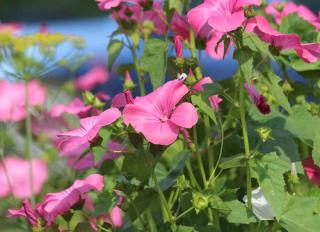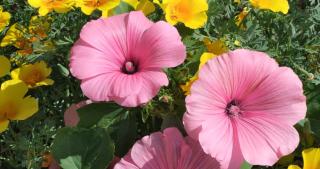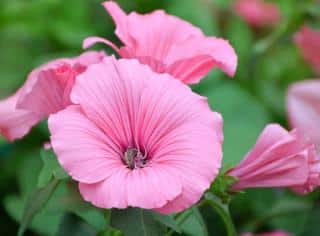

Lavatera, the tree mallow is a beautiful perennial that blooms generously for a long time.
Summary of top tree mallow facts
Name – Lavatera
Family – Malvaceae (mallow family)
Type – annual or perennial
Height – 20 to 55 inches (50 to 140 cm)
Exposure – full sun
Soil – ordinary
Foliage – deciduous
Flowering – July to October
Easy to care for, it is perfectly suited to balconies, terraces and to the garden.
 Tree mallow is best planted in spring but it can also be planted in fall, especially in areas where the winter climate is mild.
Tree mallow is best planted in spring but it can also be planted in fall, especially in areas where the winter climate is mild.
This is easy and it is even recommended to multiply your tree mallow so that the base of the plant can be regenerated over the years.
For annuals, sow in the vegetable patch directly in April and water on a regular basis.
 Tree mallow adapts perfectly to being grown in pots or garden boxes. Very hardy, it resists low temperatures down to down to 5°F (-15°C).
Tree mallow adapts perfectly to being grown in pots or garden boxes. Very hardy, it resists low temperatures down to down to 5°F (-15°C).
Although this plant doesn’t require a lot of water, it is important to water it over the 1st year after planting so that roots can develop and the plant can settle in.
 Remove wilted flowers during the blooming regularly in order to boost flower-bearing.
Remove wilted flowers during the blooming regularly in order to boost flower-bearing.
It is important to prune back short at the beginning of spring to give the plant vigor and avoid it growing too large.
A plant with abundant blooming, tree mallow also has the advantage of growing and spreading very fast.
Its flowers tend to bloom repeatedly from the month of June up until the first frost spells.
With its balanced shrubby silhouette, this annual or perennial plant will fit right in among other perennials or shrubs in a flower bed.
Tree mallow grows in the wild in the Mediterranean are, usually on rather poor and rocky ground.
Water this perennial in summer in case of prolonged dry spells or strong heat wave.
Best to water in the evening so that water isn’t lost through evaporation.
My laverteria looks nearly dead through delivery all the leaves are dead . Will it be ok pruning in spring keep in cold frame
Yes, it sounds like it suffered a lot during the transport, I’m sorry to hear that! The advantage is that this triggered the dormant phase, so your thinking is correct: it’s ready for winter. Plant it as described in the article, perhaps soak the clump in not-too-cold water for 5 minutes before putting it in the ground if you haven’t planted it yet (don’t dig it up if you’ve already transferred it to the ground). If it’s in a cold frame it’s even better, spread a little mulch (hay… or any other plant mulch) around the base to keep it warmer, too.
When spring starts coming in (be on the lookout for grape hyacinth and daffodils to give you the signal), you can go ahead and prune it. Normally it should have survived all three ordeals: transpo, transplant and winter!